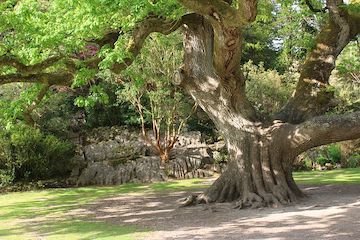The Ten Stages of the Mahayana Bodhisattva Path
The Ninth Stage
Part 11

Introduction
Stages of the Mahayana Bodhisattva Path are similar to the Theravada idea of the Noble Eight-fold Path, although not the same in the order of the stages, as well as the aim of the various stages that comprise the total trajectory that the Bodhisattva has to traverse. The idea of the Bodhisattva path is linked to the idea of bodhicitta, the aspiration of becoming enlightened, and this aim is for the benefit of all sentient beings—when compared to the Arahant idea it is distinguished by the fact, that the Bodhisattva holds off on attaining final non-returning Nirvana until all sentient beings are brought along the journey of the Bodhisattva path towards Enlightenment.
Mahayana Texts
Various Mahayana texts discuss the stages of the path in varying detail and order. For this eleventh article in the series, I’ve mainly followed the stages of the Path as explained in the Dasa Bhumika Sutra. Dasa bhumika in Sanskrit means ten stages.
In the Dasa Bhumika Sutra, a Bodhisattva is compared to gold in each stage, which is purified more and more by being heated in the goldsmith's fire until it is at last made into an ornament to be worn around the neck of a powerful wheel-turning monarch (cakravartin). The bodhisattva's splendor is likened to the light of the moon and the sun. In each subsequent stage, a Bodhisattva's glory and power (prabhava) increase a hundred-fold, a thousand-fold, a million-fold, etc..
I’ve also consulted the abhidharma-samuccaya text of Asanga, the prajna-paramita abhi-samaya-lankara, the Maha-vastu, and the Mahayana-sutralamkara text. The Avatamsaka Sutra (Flower Ornament Scripture) has great details on the 10 stages of the path as well, including the Gandavyuha commentary. For cross-reference purposes I’ve used the yogacara-bhumi text, which incorporates the Bodhisattva path into an even greater 17 stages, to verify Sanskrit terminology. The ‘Materials for a Dictionary of The Prajnaparamita Literature’ by Edward Conze has been very useful, in verifying Sanskrit terms as they are used in the various Prajna Paramita texts.

In this article, I’ll cover the ninth stage of the 10 Stages of the Mahayana Bodhisattva Path.
An interesting side-note: In summarizing the teachings of The Flower Ornament Scripture (avatamsaka sutra), the Gandavyuha, ‘The Book on Entry into the Realm of Reality’, uses the format of a journey for knowledge. Sudhana, the inspired young male pilgrim of the story, visits fifty-three teachers to learn the conduct of the Bodhisattva, the enlightening being dedicated to liberation of the hidden resources of humanity. Quite out of keeping with the modern myth that the inner circle of living Buddhism was traditionally a male monkish elite, the story represents a small minority of the teachers as monks, and nearly half as females!
Summary
Stage 9. The Proficient Thoughts stage (sadhumati bhumi)
The ninth stage is Proficient, because the Bodhisattva attains the perfection of the ten powers (bala paramita) of a Buddha, and the realization of possessing the perfection of wisdom (prajna paramita). This is also the stage the Boddhisattva prepares for leading all sentient beings to Enlightenment.
In detail
This ninth stage is called sadhumati, because in this stage the Bodhisattva’s intellectual discernments dominates (pratisamvidmateh pradhanatvat). This stage is also called Good Intellect, because of the perfection of all kinds of spiritual teachings and attainments of holy wisdom and a peaceful Mind.

Various types / levels of ignorance have been purified in the first eight stages, and in each subsequent stage the ignorance that is to be purified is more subtle and difficult to address than in the previous stage.
- In the first stage, the ignorance of clinging to person and things, and the ignorance of the defilement of wrong tendencies and actions have been purified.
- In the second stage, the ignorance of minute errors and transgressions, and the ignorance of what various actions lead to have been purified.
- In the third stage, the ignorance of greed, and the ignorance of complete mental control to retain what is learned have been purified.
- In the fourth stage, the Bodhisattva addressed the ignorance of attachment to attainments in concentration, and the ignorance of attachment to religion.
- In the fifth stage, the Bodhisattva addressed the ignorance of one-sided thought rejecting life and death, and the ignorance of one-sided thought heading for nirvana.
- In the sixth stage, the Bodhisattva addressed the ignorance of observing the flux of events at the moment, and the ignorance of elaborate active mental patterns.
- In the seventh stage, the Bodhisattva addressed the ignorance of subtle active mental patterns, and the ignorance of method in one-sided formless awareness.
- In the eighth stage, the Bodhisattva addressed the ignorance of making effort toward the formless, and the ignorance of control over forms.
- In the ninth stage, the Bodhisattva addresses the ignorance of control of the intellectual powers and mental command of ultimate understanding of infinite expressions of truth, and the ignorance of free command of special knowledge of comprehension and communication.
A Bodhisattva after completing and purifying the first eight stages of the path, enters into the ninth stage. At this stage, he truly understands and is able to make a distinction between dharmas as wholesome, unwholesome or indifferent; pure or impure; worldly or transcendental; conceivable or inconceivable; determinate (niyata) or indeterminate (aniyata). The Bodhisattva understands the purpose of the various paths of the Disciples (sravaka), Solitary Buddhas (pratyekabuddha), Bodhisattvas, and the Buddha stages (tathagata-bhumi). Through this understanding, he understands the habits (samacara) and differentiated nature (nanatva) of thoughts of sentient beings, their defilements (klesa), actions (karma), faculties (indriya), aspiration (adhimukti), elements (dhatu), desire and intention (asayanusaya), birth determined by desires (vadanusandhi) and their accumulations (rasi = three types of accumulations: 1. wrong-doing based on bad results, 2. right-doing based on good results, and 3. neither-wrong-nor-right-doing with undetermined results).

The bodhisattva’s understanding of each individual sentient being’s circumstance in this stage, allows him to modify, through skillful means, the manner in which the teaching is explained, customizing the way it is taught but not the underlying meaning of the teaching itself.
Practitioners in the ninth stage gain accurate knowledge of good, bad, neutral, mundane, and supra-mundane actions. They also know how people get entangled in defilements, acts, senses, resolutions, dispositions, inclinations, likes-and-dislikes, and habits; and they know what is beneficial or not. Practitioners also know all about the divisions of the mind, the complexity of the mind, how the mind becomes defiled, how the mind becomes bound and liberated, and how it apprehends illusions and false conclusions [based on ignorance]. Learning to become expert teachers, practitioners in this stage develop the four analytic knowledges (pratisamvid):
They attain mental command of the teachings through concentration protective spells (mantra-dharani). They learn to teach in accord with the particularities, faculties, likes-and-dislikes, and inclinations of the people they are helping.

In the ninth stage, twelve dharmas are to be completed and accomplished:

The Mahayana-sutralankara explains that this stage is so called, because a Bodhisattva has good thoughts on account of the four analytical knowledges (pratisamvid) that he acquires. A Bodhisattva now knows all phenomena and principles truly and certainly, whether they are mundane or supra-mundane, conceivable or inconceivable, compounded or uncompounded. He knows everything about the minds and hearts of men and about wholesome and unwholesome actions. He becomes a great teacher and acquires and is protected by powerful spells (dharani). He experiences many concentrations (samadhi), and cultivates the perfection of power (bala-paramita) without neglecting the other perfections.

In the next and final article in this series, I’ll be discussing The final Tenth Stage [and a bonus stage!] of the Mahayana Bodhisattva Path in full detail.
References for research:
- Boin-Webb, Sara — Abhidharmasamuccaya, The Compendium of the Higher Teaching (Philosophy) by Asanga, 2000, Asian Humanities Press.
- Cleary, Thomas — Buddhist Yoga a Comprehensive Course, The Samdhinirmochana Sutra, 1995, Shambhala Publications.
- Cleary, Thomas — The Flower Ornament Scripture, A Translation of the Avatamsaka Sutra, 1993, Shambhala Publications.
- Conze, Edward — Materials for a Dictionary of The Prajnaparamita Literature,1973, Suzuki Research Foundation.
- Conze, Edward — The Large Sutra on Perfect Wisdom with the Divisions of the Abhisamayalankara, 1975, University of California Press.
- Conze, Edward — The Perfection of Wisdom in Eight Thousand Lines and Its Verse Summary second printing, 1975, Four Seasons Foundation.
- Dayal, Har — The Bodhisattva Doctrine in Buddhist Sanskrit Literature, 1932, Motilal Banarsidass.
- Dutt, Nalinaksha — Mahayana Buddhism, 1978, Motilal Banarsidass.
- Jones, J. J. — The Mahavastu Volume 1, 1949, Luzac & Company Ltd.
- Kimura, Ryukan — A Historical Study of the Terms Hinayana and Mahayana and the Origin of Mahayana Buddhism, 1927, University of Calcutta.
- Sparham, Gareth — Abhisamayalamkara with Vrtti and Aloka in Three Volumes, 2008—2011, Jain Publishing.
- Wayman, Alex — Analysis of the Sravakabhumi Manuscript, 1961, University of California Press.
- Williams, Paul — Altruism and Reality, Studies in the Philosophy of the Bodhicaryavatara, 1998, Curzon Press.
- Williams, Paul — Mahayana Buddhism, The Doctrinal Foundations, second edition, 2009, Routledge.
- Wogihara, Unrai — Bodhisattvabhumi, 1930, Tokyo.
- The Ten Stages of the Mahayana Bodhisattva Path-The Two Preliminary Stages-Part 1
- The Ten Stages of the Mahayana Bodhisattva Path-The Two Preliminary Stages-Part 2
- The Ten Stages of the Mahayana Bodhisattva Path-The Two Preliminary Stages-Part 3
- The Ten Stages of the Mahayana Bodhisattva Path-The Two Preliminary Stages-Part 4
- The Ten Stages of the Mahayana Bodhisattva Path-The Two Preliminary Stages-Part 5
- The Ten Stages of the Mahayana Bodhisattva Path-The Two Preliminary Stages-Part 6
- The Ten Stages of the Mahayana Bodhisattva Path-The Two Preliminary Stages-Part 7
- The Ten Stages of the Mahayana Bodhisattva Path-The Two Preliminary Stages-Part 8
- The Ten Stages of the Mahayana Bodhisattva Path-The Two Preliminary Stages-Part 9
- The Ten Stages of the Mahayana Bodhisattva Path-The Two Preliminary Stages-Part 10
- The Deathless In Buddhism
- The "Timeless" Teaching-Being Beyond Temporality
- The Nine Successive Cessations In buddhist Meditations - Part 1
- The Nine Successive Cessations In buddhist Meditations - Part 2
- The Nine Successive Cessations In buddhist Meditations - Part 3
- The Twelve Links Of Dependent Origination
- THINGS to DEVELOP and THINGS to AVOID
- The First Noble Truth
- The Second Noble Truth
- The Third Noble Truth
- The Fourth Noble Truth
- 10 Fold Path Series
- EATING MEAT — WHY THE BUDDHA WAS NOT A VEGETARIAN

I will flag comment spam at 1% strength. If you keep on spamming my post, I will flag you at 100%. I don't care if you have limited English abilities, write a couple of sentences about this article, no copy-paste, please. I will flag: one sentence comments, links to your blog and begging for up-votes and follows. Also, I will flag comments that have nothing to do with my blog's article. I will also check your comment section to see if you have been comment spamming on other blogs.


 A link to My Blog
A link to My Blog
@reddust, I'm giving you big salute you coz you're covering Ten stages of Mahayana Bodhisattva path very speedy. This time nicely describe whole stage of no. nine. Buddha's lessons hasn't hide meanings. Every lessons has bet meanings and better to compare thoughts our life and then enter that into our soul. Sadhumati bhumi mentioned like as the proficient thoughts. Those stage indeed better thoughts for peaceful mind & holy wisdom.
That's point to understand much better what's ninth stage. Buddha gave through his teaching to Buddhists, controlling mindset methods and shown where's follower want to go using his holy wisdom. Buddha every time tried to bring final destination (Nirvana) Buddhists. Someone could pass Nibbana and someone false. But if We can pass to control mind via using controlling methods definitely find final destination.
@madushanka, I have to admit the 8th stage and up I don't have much to offer regarding insights. The Bodhisattvas accomplishments are so fantastical I can't really relate...
Wouldn't it be amazing to see things in all the detail right down to their little atoms and spaces in between? I don't think I would want to know what people are thinking and their conditioning, but I am not a Bodhisattva. Trying to help people fhas always been difficult. I loved the first bhumis, I could identify with developing compassion, patience, equanimity, wisdom. This super knowledge is a bit overwhelming!
He is able to speak Dharma that perfectly suits the potentials of all living beings. Hence he achieves Good wisdom and The bodhisattva understands all dharmas and is able to teach others.
@muzaifwani, understanding the conditioning of the sentient beings is an important ability if you are going to help someone see their potential and let go of their views. I would love to have just a little bit of insight into those I want to help. Most of the time when I do try and help someone I am not very helpful. Like tryng to help someone who is suffeirng grief or a traumatic trigger. I usually just sit and listen because I am at loss to saying anything helpful.
you are right !
When you are busy trying to prove that you know better, you stop listening. Without understanding the other person, how can you possibly help?
Perfect wisdom and proficient thoughts sounds like a dream but it would be wonderful to have that. Following you as I have the past several months it sounds like it's quite a process to become a Buddhist but I'm sure it's a rewards are worth it. Thanks @redxust
I can't imagine the ability to read a persons conditioning and then work with them so they can see past themselves to reality as it is...
I don't think people really have any idea how difficult it is to become a Buddha or find enlightenment. I've met many people who think they are enlightened when I go to Buddhist teachings. However only a Buddha knows the mind state of someone else so I can't judge...hehehe
To reach this ninth stage, amazing! He must be wonderful; he is already a wise teacher with radiant abilities to transmit these teachings to other beings.
I want to share the following thought that pertains to these nine stages studied:
From paths of evil he departs for eternity,
Soon to see the Buddha of Limitless Light
And perfect Samantabhadra’s Supreme Vows".
The Vows of Samantabhadra
Avatamsaka Sutra
That is where I want to go @amigoponic, leave the bad advisors behind and trip the light fantastic! Lovely quote too <3
Something happened, my avatar disappeared.
aw
I see your avator @amigoponic, must be something going on with your browser.
amigo muy bonitas las fotografias, su trabajo debe ser excelente lo felicito soy venezolano, espero contar con su ayuda y que visite mis pots diarios. gracias ,continue asi saludos
Estimado @edgargonzalez, le sugiero lee el siuente post, es para su crecimiento personal en steemit...
That was kinda quick. I'm quite expecting this Ten stages of Mahayana Bodhisattva path to be longer. Thanks for sharing this to us!
I have great resourses, however the books I used are hundreds of pages long. This is a very condensed version. Thank you @gvincentjosephm. I write abioyt one conterversial subject but no one has mentioned it yet....
I'm most learnt from you about Buddha teachings through reading your valuable contents @reddust. Perfect recovery this time also. Buddha teaching has most of mind manage methods and meditation progress. We have opportunity there for reach some top levels of Buddhism. There mentioned the ignorance of control of the intellectual powers and mental command of Bodhisattva path. Thanks to given better knowledge via your experience.
Thank you @dgragonking, I have learned a lot writing this series. In fact I have discovered several things I didn't know:
I had no idea about Bodhisattvas and their Bodhitrees. I want to paint this!
So many stages to read, ehhh...
I just want to spread love and peace around me. Sharing some with you! :D
Interesting topic, i have a question @reddust you write the whole post? i mean it's too long and if you write all you have to invest a lot of time here. Regards
I wrote the whole post, however it only takes a 3 hours. The rest of the day I paint, clean house, garden, cook, read and take notes for my next article. People who write Buddhist blogs spend hours and hours researching and writing without any rewards ;-)
Wow my friend great great job i just spend 25 minutes writing my post hehehe. Regards
We are already in the final gap in the path of Bodhisattva, and the penultimate stage to reach the path of enlightenment. I have learned a lot from you. I would like to one day possess the wisdom you have. I wait with ancias the explanation of the last stage. regards @reddust
Thank you @deisydavi, I have a lot to remember from old lessons and I am learning new things from writing these articles. Thank you!
Hello @reddust I love how little by little you enlighten us for each stage of the Mahayana Bodhisattva path. Something I did not know I am interested in knowing a little more about each stage. I like how in each publication you remind us of the previous stages, to arrive ready to the path of enlightenment.
Thank you @carrie0